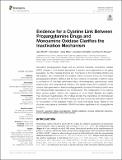Files in this item
Evidence for a cyanine link between propargylamine drugs and monoamine oxidase clarifies the inactivation mechanism
Item metadata
| dc.contributor.author | Albreht, Alen | |
| dc.contributor.author | Vovk, Irena | |
| dc.contributor.author | Mavri, Janez | |
| dc.contributor.author | Marco-Contelles, Jose | |
| dc.contributor.author | Ramsay, Rona R. | |
| dc.date.accessioned | 2018-05-28T08:30:16Z | |
| dc.date.available | 2018-05-28T08:30:16Z | |
| dc.date.issued | 2018-05-28 | |
| dc.identifier | 253086779 | |
| dc.identifier | ae51e775-56ee-48d8-992b-062770712e83 | |
| dc.identifier | 85048241260 | |
| dc.identifier | 000433176600001 | |
| dc.identifier.citation | Albreht , A , Vovk , I , Mavri , J , Marco-Contelles , J & Ramsay , R R 2018 , ' Evidence for a cyanine link between propargylamine drugs and monoamine oxidase clarifies the inactivation mechanism ' , Frontiers in Chemistry , vol. 6 , 169 . https://doi.org/10.3389/fchem.2018.00169 | en |
| dc.identifier.issn | 2296-2646 | |
| dc.identifier.other | ORCID: /0000-0003-1535-4904/work/45366199 | |
| dc.identifier.uri | https://hdl.handle.net/10023/13554 | |
| dc.description | The authors acknowledge the financial support from the Slovenian Research Agency (research core funding No. P1-0005 and P1-0012). We thank COST CA15135 for facilitating collaboration on multi-target compounds and providing support for publication. Part of this work was also supported by the bilateral cooperation between the Royal Society of Edinburgh and the Slovenian Academy of Sciences and Arts and by COST Action CM1103 which facilitated short research visits in Ljubljana and St Andrews, respectively. | en |
| dc.description.abstract | Successful propargylamine drugs such as deprenyl inactivate monoamine oxidase (MAO), a target in multi-faceted approaches to prevent neurodegeneration in the aging population, but the chemical structure and mechanism of the irreversible inhibition are still debated. We characterized the covalent cyanine structure linking the multi-target propargylamine inhibitor ASS234 and the flavin adenine dinucleotide in MAO-A using a combination of ultra-high performance liquid chromatography, spectroscopy, mass spectrometry, and computational methods. The partial double bond character of the cyanine chain gives rise to 4 interconverting geometric isomers of the adduct which were chromatographically separated at low temperatures. The configuration of the cyanine linker governs adduct stability with segments of much higher flexibility and rigidity than previously hypothesized. The findings indicate the importance of intramolecular electrostatic interactions in the MAO binding site and provide key information relevant to incorporation of the propargyl moiety into novel multi-target drugs. Based on the structure, we propose a mechanism of MAO inactivation applicable to all propargylamine inhibitors. | |
| dc.format.extent | 11 | |
| dc.format.extent | 1221290 | |
| dc.language.iso | eng | |
| dc.relation.ispartof | Frontiers in Chemistry | en |
| dc.subject | Monoamine oxidase | en |
| dc.subject | Propargylamine | en |
| dc.subject | Inhibition mechanism | en |
| dc.subject | Electrostatic interactions | en |
| dc.subject | Quantum chemical calculations | en |
| dc.subject | Isomers | en |
| dc.subject | Interconversion | en |
| dc.subject | Structure | en |
| dc.subject | QD Chemistry | en |
| dc.subject | RM Therapeutics. Pharmacology | en |
| dc.subject | NDAS | en |
| dc.subject.lcc | QD | en |
| dc.subject.lcc | RM | en |
| dc.title | Evidence for a cyanine link between propargylamine drugs and monoamine oxidase clarifies the inactivation mechanism | en |
| dc.type | Journal article | en |
| dc.contributor.sponsor | The Royal Society of Edinburgh | en |
| dc.contributor.institution | University of St Andrews. School of Biology | en |
| dc.contributor.institution | University of St Andrews. Biomedical Sciences Research Complex | en |
| dc.identifier.doi | 10.3389/fchem.2018.00169 | |
| dc.description.status | Peer reviewed | en |
| dc.identifier.grantnumber | N/A | en |
This item appears in the following Collection(s)
Items in the St Andrews Research Repository are protected by copyright, with all rights reserved, unless otherwise indicated.

